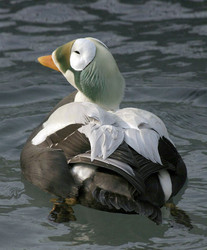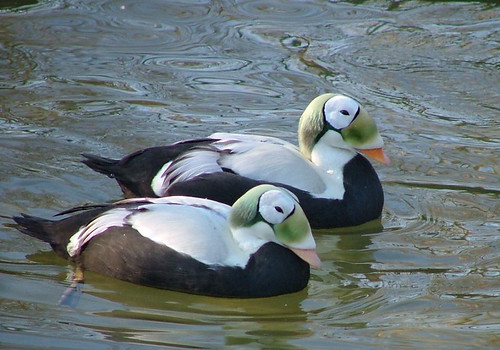
arican animals of spectacled eider duck gallery

free downloading pics of eider wiki

pictures of spectacled eider youtube

different types of ducks habitat

male and female spectacled eider ducks
The Spectacled Eider is a large sea duck, which breeds on the coasts of Alaska and northeastern Siberia.The Spectacled Eider is slightly smaller than the Common Eider at 52–57 cm in length. The male is unmistakable with its black body, white back, and yellow-green head with the large circular white eye patches which give the species its name. The drake's call is a weak crooning, and the female's a harsh croak.The female is a rich brown bird, but can still be readily distinguished from all ducks except other eider species on size and structure.The lined nest is built on tundra close to the sea, and 5–9 eggs are laid.
Spectacled eiders are diving ducks that spend most of the year in marine waters where they probably feed on bottom‑dwelling molluscs and crustaceans. Around the time of spring break‑up, breeding pairs move to nesting areas on wet coastal tundra. They establish nests near shallow ponds or lakes, usually within 3 meters (10 ft) of water. During this season they feed by diving and dabbling in ponds and wetlands, eating aquatic insects, crustaceans, and vegetation. Soon after eggs are laid, males leave the nesting grounds for offshore molting areas, usually by the end of June. Females whose nests failed leave the nesting area to molt at sea by mid‑August. Breeding females and their young remain on the nesting grounds until early September. Molting flocks gather in relatively shallow coastal water, usually less than 36 m (120 ft) deep. While moving between nesting and molting areas, spectacled eiders travel along the coast up to 50 km (31 mi) offshore. During the winter months of October through March, they move far offshore to waters up to 65 m (213 ft) deep, where they sometimes gather in dense flocks in openings of nearly continuous sea ice.
No comments:
Post a Comment